The lighting of the kitchen must be functional, and the secret of this phenomenon is multilevel. Each area of the kitchen should be lit in its own way. When placing lighting devices, many factors are taken into account, such as the dimensions of the kitchen, the location of the window, the style of the room. Let's try to figure out how to solve the problem of kitchen lighting.

What should be the general lighting?
Lighting rates for different kitchen areas vary. So, the working area should be well-lit, under the influence of such light all objects will be clearly visible, while in the dining area a slightly muffled soft light is more appropriate, not blinding people sitting at the table. But even when the owner responsibly approached the zoning with the help of light sources, the common chandelier on the ceiling will not be superfluous. Its functional component remains almost unused, because it illuminates almost empty space, however, its presence will be able to even out the unevenness of illumination. If the ceiling is suspended or suspended, then the optimal solution is the installation of ceiling lights.
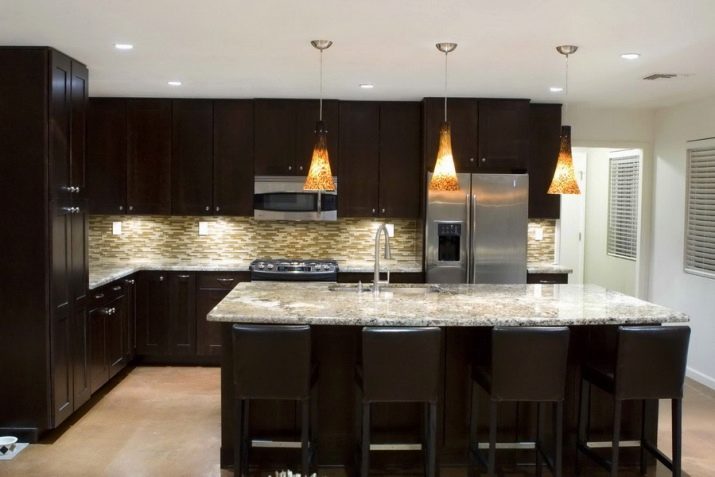

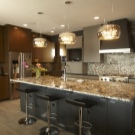

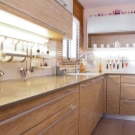

It is important to solve the problem of lighting the kitchen even at the stage of its repair, when workers stretch the wiring and mark the places for mounting sockets and switches. If you deal with this issue later, then the owner will have problems, for example, have to conduct wiring on top.
Each room has its own lighting requirements. So, for the kitchen, this figure is 150 lux per m2. For example, for a standard 12-meter kitchen you need 1800 lux.From the fact that 1 lux = 1 lm, it turns out that for this room you will need lamps that produce at least 1800 lm. In watts, these data are not considered now, since a modern 7 W LED bulb can produce as much light as a 50 W incandescent lamp.




Zoning the kitchen with the help of light, it is important to calculate the above data for both zones separately. To do this, you need to make a plan of the room, divide it into areas and calculate the number of lamps for each part. Keep in mind that one lamp per 100 watts will give almost 3 times more light than a pair of 50 watts lamps. When choosing the type of lighting, give preference to the same type of lamps: halogen, LED, daylight. A combination of two types is allowed, but if you apply all three of these, it will be overkill. All these options are characterized by different lighting, which means that it will be almost impossible to calculate the norm of lighting for the kitchen. In this case, incandescent lamps are not mentioned, because due to the large consumption of electricity and low light, they are now irrelevant.


And it is also important to use lamps of the same color, this indicator is sometimes called color temperature. Lighting devices can give out blue, yellow, white shades. For human vision and comfortable color perception in the kitchen, it is recommended to use warm or neutral options, and it is better to completely abandon the cold one, although a cold spectrum may be appropriate when lighting some work areas.


The most traditional option for kitchen lighting is the chandelier. A good option, but it does not always fit into the modern style of the kitchen. If the kitchen is made in a rectangular shape, it is recommended to select an elongated instance of the chandelier. Narrow shapes allow light to be optimally distributed throughout the kitchen. If the ceilings are low, then it is better to abandon the chandelier. As an alternative, flat lamps of a round or coal shape are suitable. On a suspended or suspended ceiling, "scattered" spotlights will harmoniously look. They can even create some abstract composition. The classic solution is to organize lighting around the perimeter of the central zone of the kitchen. This option will visually make the ceiling higher, and the kitchen more spacious.


A difficult task is the selection of lighting for owners of Khrushchev. In such apartments, the kitchens are very small - 5-7 "squares". In this case, it is not recommended to use luxurious "flashy" chandeliers and long shades - the parameters of the lighting devices must be selected in accordance with the dimensions of the room. And also in a small kitchen you do not need to place too many lighting fixtures. The best option is a small single chandelier and LED lighting of the working area.

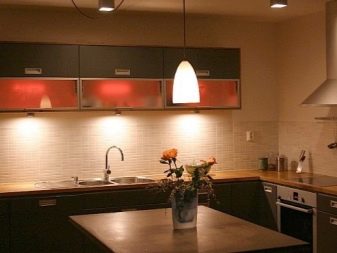
If the ceilings are too low, which is also characteristic of Khrushchev, it is recommended to install LED lamps on it, and direct their light to the ceiling. This technique will create the effect of soaring the ceiling in the air, which will visually increase its height.
How to illuminate the work area?
Not only the convenience of preparation, but also the mood of the hostess, depends on the backlight, as this element creates a general tone for the entire room. The location of the fixtures may vary.
- The bottom of the cabinets. A fashionable solution that attracts buyers with its decorative component and practical function. LED strip is passed along the bottom of the wall cabinets, so that the entire working surface is well lit. While working in the kitchen, the hostess will not have to dodge, so as not to obscure the light.


- Wall. An interesting option is the location of lighting devices above the working area. This is possible if the wall cabinets are located on the opposite side. In this situation, you can use ordinary spots or an exquisite sconce - the choice is determined by the style of the room.Place the equipment so that the light is directed clearly at the work surface.

The light above the work area should be clear and expressive. Lamps must not emit diffused, dim light. Therefore, the already mentioned devices are suitable for the working area.
- LED Strip Light. A modest but practical solution with rich lighting. The advantage is the durability of the device, as well as the ability to adjust the brightness. You can even get a remote control that can control the tape from a distance.


- Spots. Small lighting fixtures resembling a floodlight. A great option for use as a work surface lighting. The advantage of spots is the ability, if necessary, to fix the light flux in the right direction.


- Sconce. For the kitchen, any kind of sconce is suitable. It can be a lampshade or wall equipment, but it is important that a bright lamp is inserted. Such an instance is usually selected for antique and classic styles.


Dining area light
When choosing lighting units for the dining area, more attention is paid to their aesthetic function. The lamp no longer serves to supply light to the surface of the table, but for zoning the room. Light sources can be located in different places.
- On the ceiling. The most natural option. Especially this solution is suitable for a large kitchen where the table is installed in the middle of the room. The upper illumination will create subdued softened lighting, visually emphasize the table, lighten the entire dining area. This arrangement is also convenient because the devices will not interfere with diners, that is, for example, a hanging chandelier cannot be pushed or filled with liquid.


- On the table. In this case, even a regular table lamp is suitable. This option is best used for a compact, unusual kitchen, where there is no need to focus on the dining table. Naturally, the table is then located against the wall, and not in the center, in addition, it has large dimensions - when you install the lamp on a small table, it will interfere with eaters.

- On the wall. This solution is also suitable only when placing the table against the wall. It is recommended to use lamps that can be directed both down and up.


In the dining area, various lighting options can be used.
- Ceiling Chandeliers. The stores offer a wide range of these fixtures that never go out of style. Among the variety of styles and design options, each buyer will easily select the instance that is most suitable for a particular kitchen interior. For example, for the Japanese style, it is recommended to give preference to samples with a paper lampshade, for Provence - chandeliers with a floral print, for a Shebby-chic style - a crystal copy with hanging elements. In the case when the kitchen room has a long table or bar, the option of placing two chandeliers at once is quite relevant.

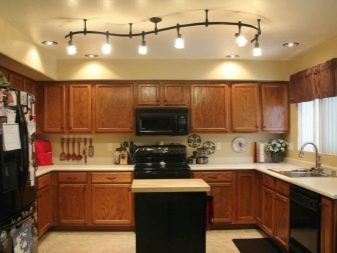
- Table lamp. She is also selected taking into account the style of the room. For English classics, designers recommend choosing metal products with glass parts, for hi-tech - completely metal lamps, for the Chinese style - wooden or even paper lighting devices. When choosing, it is important to take into account the stability of the unit, as someone will certainly push it during the meal, and you must foresee that the equipment does not break.

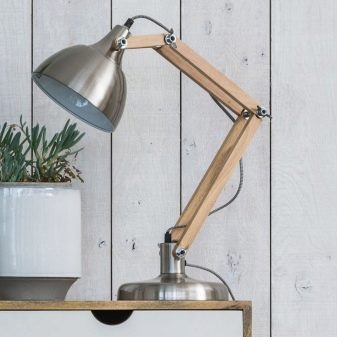
- Wall Light. As already mentioned, it will be convenient if the owner can control the direction of the light flux on the wall. Therefore, sconces, spots or LED lighting are suitable. Brightness indicators can not be especially taken into account, most importantly, aesthetics.
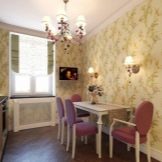



Decorative lighting
In this case, we mean types of lighting that do not perform practical functions. Their main purpose is decorative. Soft pleasant lighting can create a comfortable cozy atmosphere in the kitchen. Lamps can be located in the most unexpected places.
- Between the kitchen and the ceiling. In this case, LED strip is usually used. In this case, backlighting is some design trick. For example, the tape between the cabinets and the ceiling in a miniature kitchen visually increases the height of the room.
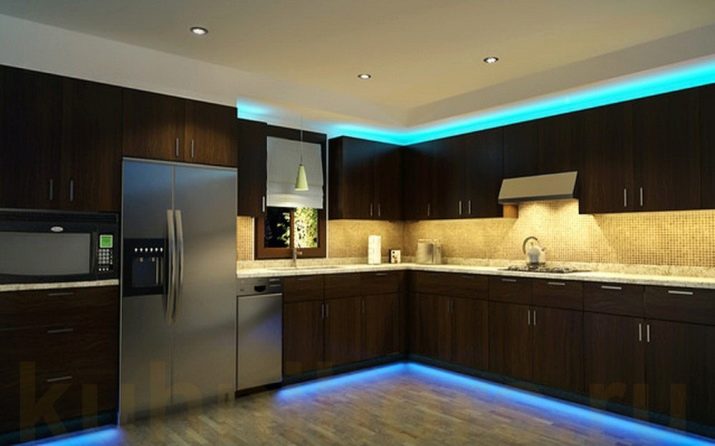
- Illumination of the basement of a furniture set. Also an interesting technique when lighting a small room. With this design, the impression of a kitchen floating in the air.


- Highlighting decorative elements. This refers to the placement of additional LED strips or sconces to focus on paintings, photographs, souvenirs and other details.

- Interior lighting cabinets. This is a very aesthetic option, in perfect harmony with the facades of frosted or stained glass. You can illuminate the inside of the wall cabinets, shelves, drawers. In this case, the decorative function is combined with the practical one - it is much more convenient to use illuminated cabinets. The best option is the use of LED strip. This appliance does not heat up, is safe to use, consumes little power and well illuminates the internal cabinets. You can set the equipment to work continuously or turn on only when the drawer is pulled out.

- Illumination of a stove or hob. Quite a rare option, which is again used mainly as a decoration. To keep an eye on the pan, the hostess needs enough general light. Usually, such a backlight is built into the hood of the hood, although most modern models already automatically come with this type of backlight.

- Backlight in the floor. Used as a separation of functional space. It is also used very rarely, but it looks very elegant.

Beautiful examples
Pay attention to interesting kitchen lighting projects.
- Backlight integrated in floor height difference. Good idea of zoning a kitchen space. The floor illumination does not carry a special functional load, although it will not allow the guest to stumble over the step. It looks very stylish, bright, modern. Pay attention to the classic lighting of the working area.

- In this case, the working surface and the dining area are highlighted by hanging shades.while the compact kitchen table is lit by a separate ceiling fixture. And also spotlights "scattered" on the ceiling. The overall composition is very harmonious and neat.

- Despite the compact kitchen space, the owners of this kitchen managed to decorate and zone the kitchen according to all the rules. A wall lamp is installed above the table, spotlights are mounted in the ceiling around the perimeter of the working area, and, finally, a common chandelier made in the style of a wall lamp makes the lighting of various devices even, as if smoothing it.

See how to choose the right lighting in the kitchen in the next video.










